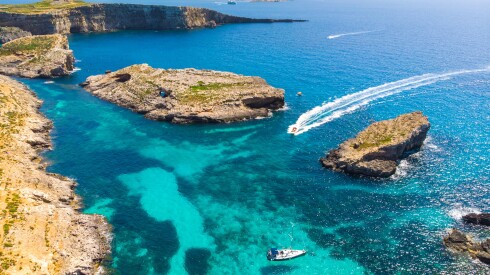From Milwaukee and the beaches of Lake Michigan to the wild rocky shores of Lake Superior, Wisconsin doesn’t get its coastal do. This is the nation’s “Fresh Coast,” and the adventures here are fresh, to be sure.
Picture it: Cold-water surfing. Scouting for shipwrecks. Climbing dunes and leaping off cliffs. Chasing waterfalls and napping on empty beaches. Wandering a tribal park and catching ribbons of northern lights. You could fly over the Dairy State, but then you’d never experience what can happen on—and near—the water.
This is how to spend a day (or three) on the Fresh Coast.

Milwaukee Art Museum’s iconic Burke Brise Soleil, movable sunscreen “wings,” was designed by Spanish architect Santiago Calatrava.
Photo by JHVEPhoto/Shutterstock
Find art on the water in Milwaukee
Some 30,000 works of art sit inside the Milwaukee Art Museum, but the pièce de résistance is the museum itself. Designed like a bird alighting on the shore, the museum’s Burke Brise Soleil, aka its “wings,” stretch open and shut twice a day—a 217-foot wingspan that also flaps gently at noon. The museum is set right on the waters of Lake Michigan, and while there you can wander the surrounding paths and gardens, where every angle offers a new perspective on art, architecture, and water. And the inside of museum is also a knockout: The walls are bedecked with paintings by O’Keeffe, Rembrandt, Monet, Picasso, Warhol, and Rothko.
Surf on a storm in Sheboygan
Some call Sheboygan the “Malibu of the Midwest,” but Malibu doesn’t know how to scrape a windshield, much less surf winter winds on Lake Michigan. Just north of Milwaukee, Sheboygan’s surfing season technically runs year-round, but the best waves rollick from August to April. The die-hard surfers are out there in January, riding 25 mph winds in 30º F temperatures. Even in September when the air is warm, a wet suit is essential.
If you’re not looking to test your buoyancy in fresh water—another added factor in Great Lakes surfing—hit the beaches for some wild spectating. Scout out North Beach or Kohler-Andrae State Park on a windy morning, and you’ll see Sheboygan’s signature show.

The Cana Island lighthouse, on the shores of Lake Michigan, is one of Door County’s popular attractions.
Photo by Keith Homan/Shutterstock
Hunt for lighthouses and shipwrecks in Door County
With nearly 300 miles of shoreline, Door County has one of the longest coasts of any county in America. You can probably picture it—it’s the thumb part of Wisconsin’s hand shape.
The entire area is part of the Niagara Escarpment, an ancient wall of rock that stretches from here to the eponymous New York waterfall. The rocky bluffs make the waters particularly treacherous, earning the tip of Door County a wild nickname: Death’s Door. Roughly 250 shipwrecks have been documented here, with about 25 easily accessible with shipwreck diving or clear-bottom kayak tours.
Then there’s the county’s lighthouses for those who prefer solid ground. With 11 beaming structures, Door County has the most lighthouses of any county in the USA. At a minimum, check out Cana Island Lighthouse in Baileys Harbor and Eagle Point Lighthouse in Peninsula State Park.
Chase waterfalls in Marinette
Wisconsin is awash with waterfalls, but Marinette County has 15 to itself. So this is a great spot for a quick waterfall-athon. A $5 day pass to Marinette County Parks is ideal: Most of the waterfalls are within a one-hour drive—and most require just a short hike to the churning cascades. Eighteen Foot Falls and Long Slide Falls in the Marinette County Forest, plus Strong Falls at Goodman County Park are each standouts, though the tread on your hiking boots will determine your destination.
After waterfall hunting, you’re less than an hour from Green Bay—a fine spot for a waterfront toast (and perhaps some requisite cheese curds).
Kayak the Apostle Islands
There’s a movement to turn the Apostle Islands into Wisconsin’s first national park, and that should tell you where to set your expectations for this national lakeshore. The 22 islands along 12 miles of coast make this spot decidedly Caribbean-esque, especially where the sand turns to cliffs and the water turns turquoise. Book a kayak tour from Bayfield (or head out on your own) and float into dark coastal caves, among dots of forest, or even inland to the rivers and sloughs.
The other iconic activity here is a boat tour—the Grand Tour, to be precise. Your captain will cover 55 miles of scenery in roughly 2.5 hours, and you’ll see why they call these islands the “jewels of Lake Superior.”
Camp on Madeline Island
Madeline Island is technically the largest of the Apostle Islands, but it’s not a part of the national lakeshore. It offers a distinctly different kind of adventure.
A 20-minute ferry ride out of Bayfield lands you on this island sanctuary, where nature blends with art and easy-access amenities. One minute, you’re camping at Big Bay State Park and hiking along the rocky coast of Lake Superior, the next you’re throwing back a Spotted Cow at Tom’s Burned Down Cafe. (Or maybe you’ll be sipping demure cocktails at the Inn on Madeline Island.)
Explore Frog Bay Tribal National Park
The nation’s first tribal national park sits just beyond Bayfield, on the Red Cliff Band of Lake Superior Chippewa reservation. Frog Bay Tribal National Park may only be 175 acres, but good things come in this small package. The park is a symbol of a growing movement: Its status as a tribal national park permanently protects a large tract of at-risk boreal forest, right on the edges of Lake Superior.
With a 1.7-mile rustic trail system and interpretive signs in English and Ojibwe, this spot is less about breaking a sweat and more about contemplating and appreciating your world. It’s a beautiful spot, indeed—especially when it’s one you don’t fly over.











